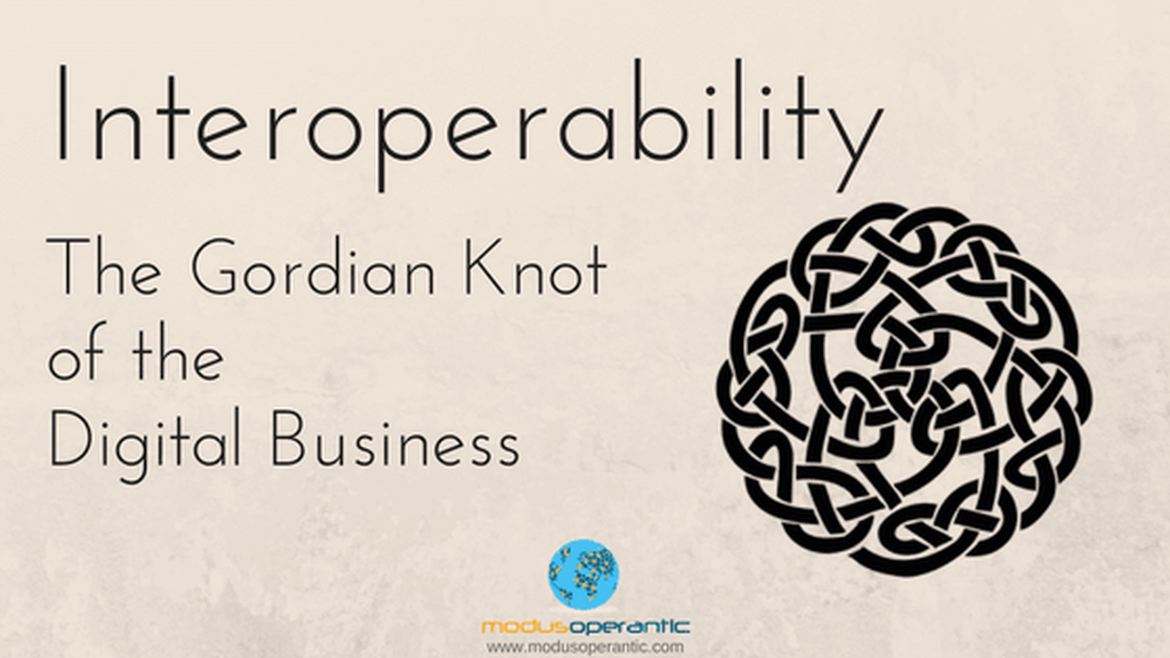¡HI! If you want to propose us a project, send a mail to info@albatian.com


ALL INFORMATION ABOUT
BPM, PROCESS, R & D, TECHNOLOGY
Interoperability: The gordian Knot of the digital business
Por Manuel Jesús Morales, Interoperability and Service Orientation Expert

In recent years, Interoperability has become more and more a key feature of Information Society. Both companies and governments, from local entities to international ones, are putting the emphasis on Interoperability.
Laws are enacted that push companies and public organizations to enable interoperability for the services they are providing to their citizens.
International committees and workgroups are created focused on defining reference models, that should enable companies and public administrations to reach interoperability.
But, what does Interoperability actually mean? Why is it being given so much importance?
In this article, I will try to clearly place the concept and its importance, which in my opinion is absolutely key for today and future Information Society, companies and public organizations.
INTEROPERABILITY WITH CITIZENS.
We often refer to Interoperability as the ability to exchange information between a particular entity and citizens.
In this approach, we can find several services that different public administrations have published on their websites. These services allows us to schedule an appointment with our doctor, request our tax information, request information about our social contributions, request cadastral information, etc, etc.
Following the same approach, we can also find the services that many private and public organizations provide to their customers and users through Apps in their mobile devices.
Certainly, making information available to citizens is important. And not just from a common sense point of view, but also because it’s being increasingly demanded by laws in more and more areas.
INTEROPERABILITY AND INFORMATION.
You may think that the lead in this story is the citizen, but here comes the first nuance: in Interoperability, the lead is information.
Because, what’s the use of providing information to citizens, if such information is not precise, complete and safe?
But, for the information to be available for the citizen, it has been earlier entered, processed and stored into the entities’ Information Systems. Therefore, it is crucial the way in which information is managed within companies and public organizations. And it is now, when we are getting closer to the real meaning of Interoperability.
All these entities are “departmented”. Information is usually processed and stored by each department, by each functional or business area. However, when all that scattered information is combined, is when it brings the highest value to the citizen, as well as the entity itself (and hence Big Data, Business Intelligence, etc).
Concerning the information in each area, some things happen of special interest in our context:
- Firstly, certain information is usually needed in many different areas.
- Besides, very often certain information in one area, is needed in certain use cases in other areas.
- And lastly, there are certain data that is considered corporate information, and therefore it must be common for all areas.
As a response to the need of certain information, shared by some areas, entities usually receive, process and store such information through different information systems. Too often, this happens due to a lack of coordination and governance over the different business areas involved, and the decisions they make regarding systems development.
This approach usually leads to redundant information, which in itself is not a problem, provided it’s under control. The trouble is that it is not usually under control, and each system gathers and processes that information its way. And then redundancy is not the problem, but the lack of referential integrity: the worst thing that can happen to a data set.
Regarding the information in one business area, that is needed by other areas for certain use cases, different types of integration solutions are usually found:
- Point to point, defining a customized solution for the systems involved, to solve the particular use case. This is similar to designing a car seat for a particular person.
- Delayed, with solutions that move the information through batch processes every certain period of time, previously scheduled. This causes that, between every two batch executions, information is not consolidated and therefore it is not consistent between the business areas involved.
- Even semi-automatic procedures are often enabled, which require some user’s action to duplicate the data, send spreadsheets, listings, etc. This implies assuming a high risk of error, added to the previous problem described.
These solutions may bring some kind of result that could be considered enough for the existing need, but are far away from being the best solution, and of course are very far from Interoperability, since they cause some of the serious problems that Interoperability comes to solve and avoid.
Lastly, there are those corporate data that should be common for all the organization. We usually refer to them as Master Data, and their proper management is in the root of Semantic Interoperability. Often, entities don’t have a clear strategy for Master Data management, which causes frequent errors of data inconsistency. These errors usually appear at the top of the “integration errors” listings.
THE MIRAGE OF SUPPOSED INTEROPERABILITY
It may seem that, even with the usual solutions exposed above, and many more, we can achieve Interoperability, and we are able to provide our customers and users with a set of high-value services. And we may think that our Interoperability internal needs are solved.
But…
- Can you change your services without affecting other systems?
- Can you change your systems without affecting other services?
- Can you replace a system with another without affecting their services?
- How much does it cost to evolve or replace the services? How many systems would be affected?
- How much does it cost you to evolve or replace the systems? How many services and systems would be affected?
- How much doest it cost to adapt your systems and services to a new requirement?
- How much does it cost you to replace a system with another? Can you do it or the risk and impact is just too high?
Usual solutions that are still being widely used by private and public entities, may enable them, in the end, to share information and functionalities with other systems and with citizens. But, at what cost? By which deadlines? With which consequences?
All this scenario builds some kind of mirage of Interoperability. And it makes many professionals assure that they have the Interoperability challenge solved, whereas, actually, they have not.
Because when they want to evolve a system, it is very likely that they find themselves pushed to modify, at the same time, other surrounding systems just because they are coupled with each other, that is, the solutions designed have arised dependencies between them. These projects, for this reason, very often are much more complex, large and expensive than they should be. And they may even become simply unfeasible.
This example is just one of the problems that come with the solutions that entities usually use to solve their Interoperability requirements. It is likely the most frequent, and it’s enough to evidence that, actually, the Interoperability challenge is not resolved by these entities at all.
THE INTEROPERABILITY STRATEGY
Interoperability is a strategic issue, absolutely key in organizations’ ICT management, and it answers optimally the questions previously listed.
Interoperability is the ability of an organization to share data and processes between its information systems, with other organizations and with its users or customers.
When processes are shared, it is called Functional Interoperability, and when data are shared, it is known as Semantic Interoperability, which refers to the need that data should not only be exchanged, but also mean the same in all systems. To achieve this, a proper Master Data management is necessary.
An optimal Interoperability strategy should allow to achieve those goals in a cost-efficient and time-efficient way, even significantly decreasing system maintenance costs.
To achieve a proper Interoperability strategy, the first step is to analyze the initial situation of the organization. Its systems map, Interoperability requirements, Business Processes, the way it faces IT projects with integration requirements (almost all of them), how they are managing their Master Data, at which level of standardization their data are, the level of reusability that could be achieved, etc, etc… all these items should be analyzed in depth.
With a clear diagnosis, it is possible to identify the steps that should be taken in order to, following a roadmap that is usually a long stroke, enable the digital organization to achieve an interoperable, scalable and cost-efficient Information Ecosystem.
In such target scenario, technology is aligned with Business Processes, and both layers, business and technology, become decoupled. This way, the organization may react efficiently to the new business needs brought by the constant changes in the market.
Information systems exchange information in a decoupled way, through standard, autonomous, abstract, composable and reusable services, with a very important positive effect on project deadlines and costs.
The whole Information Ecosystem increase its scalability and agility to adapt quickly to their customers, users and market needs.
The organization improves its competitiveness and adaptive capacity, two features that go hand in hand in business world of today and tomorrow.
RELACIONADO
-
Industry 4.0: the bpm challenge
by 4 July 9, 2017
-
Managing the customer experience is general value for the brand
by 4 Sept. 6, 2018
-
Not enough with an independent Management of a Process
by 4 May 9, 2017
-
Prevención y Gestión de los Riesgos Legales en la Empresa, algo más que una visión Penal
by 4 May 8, 2017
-
Does your company have a Digital Culture?
by 4 Dec. 17, 2018
-
Process Digitalization in Digital Transformation
by Albatian Jan. 9, 2017











